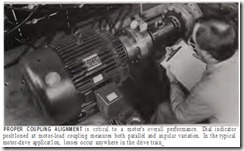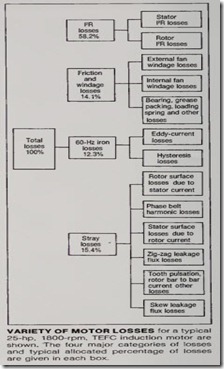Consider practical aspects when buying high-efficiency motors
By RAY E. TIMPONE, M anager of Engin eering, Small Motor Div.,Marathon Electric Manufacturing Corp., Wausau, WI JUST A FEW YEARS BACK when a
motor n eeded r eplacement, the plant electrician would dust off the name plate, and the normal tendency was to take the easy route-simply order the sam e brand, size, model, etc. In some instances, it was prudent to check out th e motor for possible rebuilding, if appropriate. Likewise, when buying a new motor for a routine application, th e plant electrical engineer or chief electrician would often take the sure and simple route-select a brand, a type, hp, speed, etc., that corresponded with an existing installation. This was a fast, practical and effective way to get the job done-back then.
Not anymore. Today, cost of energy is significant, and motors account for the most sizeable chunk of the electric power bill. Therefore, it is vitally important to consider the efficiency of any n ew or replacement motor installation.
In addition to the usual motor-selection factors-NEMA design, hp, speed, frame size, voltage, enclosure, duty, mounting, etc.-cost must now receive special attention. The initial cost, of course, is important. But now, total owning costs and related factors should also be considered. Furthermore, the total motor installation should be care fully evaluated. This includes not only the motor but also the load and con lCCti ng drive train, which could be a direct coupling, belts, gears or other apparatus. The entire motor drive should be carefully selected for maxi mum efficiency.
Motor-drive efficiency
Many people believe that a motor consumes all the electrical energy that is fed into it. Actually, it consume only that part that is not passed on to the driven equipment. If 80 kW are delivered to a motor that is 90% effi cient, the motor consumes (converts to heat) 8 kW (10% of 80 kW) and trans fers the rest of the energy (72 kW) to the pump, compressor, or fan that it is driving. If the pump, compressor, or fan is 60% efficient, then it consumes 28.8 kW (40% of 72 kW) in the act of doing its job. If a pump converts the remaining energy to fluid motion in a pipe, energy is lost in the process. This process continues until each watt can ‘1e accounted for. It usually turns out that the motor is one of the most efficient parts of the system.
Frequently, something as simple as alignment between couplings can influ ence efficiency by a significant amount. As misalignment increases, the energy transmitted through a coupling is red•1ccd. If the cost of energy is $.04/kWh and the efficiency of a 100- hp motor is reduced by o.s’ percentage points, the cost to the user will be in the range of $100-$200 per year or more if the motor runs continuously. Other factors to keep in mind are the importance of good ventilation in the area of the motor, as well as keeping the motor clean. Both will help to maintain efficient operation and extend the life of the motor.
Motor losses
It is important to retain a clear terse u derstanding of motor lossc;and maJor techniques used to reduce these losses.
The energy that is not transmitted to the driven equipment is usually re ferred to as the motor losses. These lo ses are equal to the power input mmus the power outptit. The energy refe red to as the losses, results i heatmg the various components of the motor.
. Motor losses can be broken down mto four categories, each with differ ent characteristics.
fiR losses. These losses result from the energy it takes to drive current through a conductor. This loss is calcu l ted. by squaring the current and multJplymg by the resistance. There arccurrent-carrying conductors in both the rotor (rotating part) and stator (stationary part), and consequently they both have f2 R losses. The usual echnique to minimize these losses is to mstall larg r copper (not aluminum) conductors m the windings.
Friction and windage. It takes energy to overcome the friction in the bearings. Energy is lost in the bearing and results in raising the temperature of . t e bearing and bearing grease. FnctiOn adds to the load placed on the motor by the driven equipment. Wind age refers to the resistance that air presents to such rotating parts as cool ing fans. Cooling fans also add to the load placed on the motor. Smaller fans nd ant!friction or high-quality bear Ings will help to minimize these losses.
Core losses. There are two basic components to core losses: hysteresis and eddy currents. A magnetic field is created in the steel cores of the motor. This magnetic field is changing very
;apidly. The steel cores have a magnet IC memory called hysteresis, which must be overcome. Energy is lost in the process of overcoming this magnetic memory. Hysteresis losses can be reduced by using special, rather expen sive steel. Use of these steels depends on the value of the efficiency advan tages gained vs the increase in cost.
The other type of core loss, eddy current loss, results from electric cnr rcnts that circulate in the steel and produce no torque. Motor manufactur ers usc steel made from thin sheets and sometimes special materials to mini mize these losses.
 PROPER COUPLING ALIGNMENT is critical to a motor’s overall performance. Dial indicator poslt1oned at motor-load coupling measures both parallel and angular variation. In the typical motor-dnve appllcat1on, losses occur anywhere in the drive train Stray load losses. These include sev eral types of losses that are difficult to measure and vary as the load on the motor varies. In some respects it can be said that they are related to motor disymmetrics, such as the existence of rotor and stator slots ir. the steel cores. Because these losses are hard to quan tify, they are generally lumped togeth er and produce much of the variation that is found in different test methods.
PROPER COUPLING ALIGNMENT is critical to a motor’s overall performance. Dial indicator poslt1oned at motor-load coupling measures both parallel and angular variation. In the typical motor-dnve appllcat1on, losses occur anywhere in the drive train Stray load losses. These include sev eral types of losses that are difficult to measure and vary as the load on the motor varies. In some respects it can be said that they are related to motor disymmetrics, such as the existence of rotor and stator slots ir. the steel cores. Because these losses are hard to quan tify, they are generally lumped togeth er and produce much of the variation that is found in different test methods.
An accompanying diagram illustrates the distribution of losses in a typical 25-hp, TEFC motor for various categories. The number in each box shows the percentage of the losses usu ally encountered in that loss category.
This particular 25-hp motor has anefficiency of 90% at rated hp using IEEE 112A, Method B (see below). If design changes could be made that would reduce the losses by 25%, the gain in efficiency would be only 2.5 percentage points, to 92.5%.
Measuring motor efficiency
Members of the National Electrical Manufacturer’s Association (NEMA) have agreed to use a standard created by the Institute of Electrical and Elec tronic Engineers (IEEE) for testing 3-phase induction motors. The stan dard is called IEEE 112A-Method B and is important because it provides a consistent efficiency measurement technique for those who use it.
Responsible motor manufacturers feel that this test procedure produces more-accurate results and consequently have accepted it as their test method. Unfortunately, some manufac turers use procedures that tend to result in higher efficiency ratings. Rat ings are expressed as “Motor efficiency numbers.” These numbers may mis lead the user into thinking he is getting more than he really is, unless the prop er test has been made.
Also, it is important to know the horsepower clelivm:ed by the motor for the given efficiency. Ideally, the motor horsepower and efficiency required will be available at the load in each specific applicaton. It is important to be aware that this horsepower is not necessarily the same as rated hp.
Motor load and efficiency
Efficiency varies as the load on the motor changes. This, of course, makes it important to know what horsepower the motor must deliver throughout its duty cycle to evaluate a motor’s energy cost. Efficiency is not always highest at rated horsepower. In fact, in many motors the efficiency is higher at % load than at fu ll load.
A higher-horsepower motor typicallyhas a much flatter efficiency curve than one with a lower horsepower. This means that a 100-hp motor is likely to have the same efficiency at full load as at 1/4 rated load, while for a 5-hp motor the efficiency at 1 rated load will be considerably less than at full load (see accompanying curves).
Voltage unbalance
If the voltage delivered to the motor is unbalanced, a significa nt amount of energy can be lost. If this unbalance is a result of internal plant loads, perhaps a few modifications will improve the voltage balance and save money. If the service to the plant results in unbal anced voltage, the utility should be consulted and be expected to take cor rective action. Sizable reductions in efficiency can occur with unbalance as low as 1% of the rated voltage.
Payback calculations
Much has been written about the various methods of calculating the economics of high-efficiency motors.
All have their place, whether they besimple payback calculations or present value, life-cycle costing. However, it is also possible to construct “rules of thumb” to judge whether a particular application warrants consideration for a higher-efficiency ·motor. A good strategy is to concentrate on the num ber of hours the motor will operate. If you need a replacement motor or a motor for a new application that will be operating for more than 2500 hours per year at rated horsepower, you can count on less than a 3-year payback if you buy a higher-efficiency motor. This assumes $.04 per kWh and a motor that has a significantly higher efficien cy than a standard motor. If your energy costs are different, make the appro priate adjustmen t to the estimated payback. You must also make sure th at the motor under consideration really is higher in efficiency. This example assumed that the efficiency difference was two percentage points between the motors being compared.
It would be ideal to make a precise calculation of the life-cycle cost of an electric motor, but sometimes it just isn’t practical.
